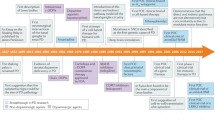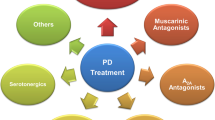Abstract
Despite advances in the treatment of Parkinson’s disease there are still many unmet needs, including neuroprotection, treatment of motor complications, treatment of dyskinesia, treatment of psychosis, and treatment of nondopaminergic symptoms. In this review, I highlight the obstacles to develop a neuroprotective drug and some of the treatment strategies recently approved or still in clinical trials designed to meet these unmet needs.
Similar content being viewed by others
References
Brichta L, Greengard P, Flajolet M. Advances in the pharmacological treatment of Parkinson's disease: targeting neurotransmitter systems. Trends Neurosci 2013;36:543–554.
Hauser RA. Future treatments for Parkinson's disease: surfing the PD pipeline. Int J Neurosci 2011;121(Suppl. 2):53–62.
Jankovic J, Poewe W. Therapies in Parkinson's disease. Curr Opin Neurol 2012;25:433–447.
Poewe W, Mahlknecht P, Jankovic J. Emerging therapies for Parkinson's disease. Curr Opin Neurol 2012;25:448–459.
Le W, Sayana P, Jankovic J. Animal models of Parkinson's disease: A gateway to therapeutics? Neurotherapeutics. 2013 Oct 25 [Epub ahead of print].
Visanji NP, Orsi A, Johnston TH, et al. PYM50028, a novel, orally active, nonpeptide neurotrophic factor inducer, prevents and reverses neuronal damage induced by MPP + in mesencephalic neurons and by MPTP in a mouse model of Parkinson's disease. FASEB J 2008;22:2488–2497.
Schneider JS, Gollomp SM, Sendek S, Colcher A, Cambi F, Du W. A randomized, controlled, delayed start trial of GM1 ganglioside in treated Parkinson's disease patients. J Neurol Sci 2013;15:140–148.
Hirsch EC, Jenner P, Przedborski S. Pathogenesis of Parkinson's disease. Mov Disord 2013;28:24–30.
Shapira AH, Olanow CW. Neuroprotection in Parkinson Disease: mysteries, myths and misconceptions. JAMA 2004;291:358–364.
Gasser T, Hardy J, Mizuno Y. Milestones in PD Genetics. Mov Disord 2011;26:1042–1048.
Le W, Sayana P, Jankovic J. Animal models of Parkinson's disease: A gateway to therapeutics? Neurotherapeutics 2013 Oct 25 [Epub ahead of print].
Olanow CW, Kordower J. Modeling Parkinson’s disease. Ann Neurol 2009;66:432–436.
Dawson TM, Ko HS, Dawson VL. Genetic animal models of Parkinson's disease. Neuron 2010;66:646–661.
Wu Y, Le W, Jankovic J. Preclinical biomarkers of Parkinson’s disease. Arch Neurol 2011;68:22–30.
Goetz CG, Tilley BC, Shaftman SR, et al. for the Movement Disorder Society UPDRS Revision Task Force. Movement Disorder Society-sponsored revision of the Unified Parkinson's Disease Rating Scale (MDS-UPDRS): Scale presentation and clinimetric testing results. Mov Disord 2008;23:2129–2170.
The Parkinson Progression Marker Initiative (PPMI). Parkinson Progression Marker Initiative. Prog Neurobiol. 2011;95:629–635
Brück A, Aalto S, Rauhala E, Bergman J, Marttila R, Rinne JO. A follow-up study on 6-[18 F]fluoro-L-dopa uptake in early Parkinson's disease shows nonlinear progression in the putamen. Mov Disord 2009;24:1009–1015.
Rascol O, Fitzer-Attas CJ, Hauser R, et al. A double-blind, delayed-start trial of rasagiline in Parkinson’s disease (The ADAGIO Study): Secondary and additional endpoints. Lancet Neurol. 2011;10:415–423.
Leber P. Slowing the progression of Alzheimer disease: methodological issues. Alzheimer Dis Assoc Disord. 1997;11:S10-S21.
Bhattaram VA, Siddiqui O, Kapcala LP, Gobburu JVS. Endpoints and analyses to discern disease-modifying drug effects in early Parkinson’s disease. AAPS J 2009;11:456–464.
Olanow CW. Hauser R, Jankovic J, et al. A randomized, double-blind, placebo-controlled, delayed start study to assess rasagiline as a disease modifying therapy in Parkinson’s disease (The ADAGIO Study): Rationale, design, and baseline characteristics. Mov Disord 2008;23:2194–2201.
Olanow CW, Rascol O, Hauser R, et al. A double-blind, delayed-start trial of rasagiline in Parkinson's disease. N Engl J Med 2009;361:1268–1278.
Carroll CB, Zeissler ML, Hanemann CO, Zajicek JP. Δ9-tetrahydrocannabinol (Δ9-THC) exerts a direct neuroprotective effect in a human cell culture model of Parkinson's disease. Neuropathol Appl Neurobiol. 2012;38:535–547.
Fahn S, Oakes D, Shoulson I, et al. Levodopa and the progression of Parkinson's disease. N Engl J Med 2004;351:2498–2508.
Olanow CW, Kieburtz K, Stern M, et al. Double-blind, placebo-controlled study of entacapone in levodopa-treated patients with stable Parkinson disease. Arch Neurol 2004;61:1563–1568.
Stocchi F, Rascol O, Kieburtz K, Poewe W, Jankovic J, Tolosa E, et al. Initiating levodopa/carbidopa therapy with and without entacapone in early Parkinson disease: The STRIDE-PD study. Ann Neurol 2010;68:18–27.
Ingman K, Naukkarinen T, Vahteristo M, Korpela I, Kuoppamäki M, Ellmén J. The effect of different dosing regimens of levodopa/carbidopa/entacapone on plasma levodopa concentrations. Eur J Clin Pharmacol 2012;68:281–289.
Hauser RA, Ellenbogen AL, Metman LV, et al. Crossover comparison of IPX066 and a standard levodopa formulation in advanced Parkinson's disease. Mov Disord 2011;26:2246–2252.
Hauser RA. IPX066: a novel carbidopa-levodopa extended-release formulation. Expert Rev Neurother 2012;12:133–140.
Pahwa R, Lyons KE, Hauser RA, et al.; APEX-PD Investigators. Randomized trial of IPX066, carbidopa/levodopa extended release, in early Parkinson's disease. Parkinsonism Relat Disord 2013 Sep 5 [Epub ahead of print].
Hauser RA, Hsu A, Kell S, et al. IPX066 ADVANCE-PD investigators. Extended-release carbidopa-levodopa (IPX066) compared with immediate-release carbidopa-levodopa in patients with Parkinson's disease and motor fluctuations: a phase 3 randomised, double-blind trial. Lancet Neurol 2013;12:346–356.
Lewitt PA, Ellenbogen A, Chen D, et al. Actively transported levodopa prodrug XP21279: a study in patients with Parkinson disease who experience motor fluctuations. Clin Neuropharmacol 2012;35:103–110.
Nutt JG, Obeso JA, Stocchi F. Continuous dopamine receptor stimulation in advanced Parkinson’s disease. Trends Neurosci 2000;23:109–115.
Stocchi F, Ruggieri S, Vacca L, Olanow CW. Prospective randomized trial of lisuride infusion versus oral levodopa in PD patients. Brain 2002;125:2058–2066.
Stocchi F, Vacca L, Ruggieri S, Olanow CW. Infusion of levodopa methyl ester in patients with advanced PD: A clinical and pharmacokinetic study. Arch of Neurol 2005;62:905–910.
Nyholm D, Klangemo K, Johansson A. Levodopa/carbidopa intestinal gel infusion long-term therapy in advanced Parkinson's disease. Eur J Neurol 2012;19:1079–1085.
Nyholm D. Duodopa treatment for advanced Parkinson's disease: A review of efficacy and safety. Parkinsonism Relat Disord 2012;18:916–929.
Klostermann F, Jugel C, Bömelburg M, Marzinzik F, Ebersbach G, Müller T. Severe gastrointestinal complications in patients with levodopa/carbidopa intestinal gel infusion. Mov Disord 2012;27:1704–1705.
Urban PP, Wellach I, Faiss S, Layer P, Rosenkranz T, Knop K, Weis J. Subacute axonal neuropathy in Parkinson's disease with cobalamin and vitamin B6 deficiency under duodopa therapy. Mov Disord 2010;25:1748–1752.
Sampaio C, Bronzova J, Hauser RA, Lang AE, Rascol O, van de Witte SV, Theeuwes AA; Rembrandt/Vermeer Study Groups. Pardoprunox in early Parkinson's disease: results from 2 large, randomized double-blind trials. Mov Disord 2011:1464–1476.
Jackson MJ, Andree TH, Hansard M, et al. The dopamine D(2) receptor partial agonist aplindore improves motor deficits in MPTP-treated common marmosets alone and combined with L-dopa. J Neural Transm 2010;117:55–67.
Stocchi F, Arnold G, Onofrj M, et al.; Safinamide Parkinson's Study Group. Improvement of motor function in early Parkinson disease by safinamide. Neurology 2004;63:746–748.
Stocchi F, Borgohain R, Onofrj M, et al.; Study 015 Investigators. A randomized, double-blind, placebo-controlled trial of safinamide as add-on therapy in early Parkinson's disease patients. Mov Disord 2012;27:106–112.
Schapira AH, Stocchi F, Borgohain R, et al.; Study 017 Investigators. Long-term efficacy and safety of safinamide as add-on therapy in early Parkinson's disease. Eur J Neurol 2013;20:271–280.
Grégoire L, Jourdain VA, Townsend M, Roach A, Di Paolo T. Safinamide reduces dyskinesias and prolongs l-DOPA antiparkinsonian effect in parkinsonian monkeys. Parkinsonism Relat Disord 2013;5:508–514.
Schapira AH, Fox S, Hauser R, et al. on behalf of the SETTLE Investigators. Safinamide add on to L-dopa: A randomized, placebo-controlled, 24-week global trial in patients with Parkinson’s disease (PD) and motor fluctuations (SETTLE). Presented at the 65th Annual Meeting of the AAN, San Diego, CA, 3/18-21/1320:271–280.
Bonifácio MJ, Sutcliffe JS, Torrão L, Wright LC, Soares-da-Silva P. Brain and peripheral pharmacokinetics of levodopa in the cynomolgus monkey following administration of opicapone, a third generation nitrocatechol COMT inhibitor. Neuropharmacology 2013;77C:334–341.
Hillion J, Canals M, Torvinen M, et al. Coaggregation, cointernalization, and codesensitization of adenosine A2A receptors and dopamine D2 receptors. J Biol Chem 2002;277:18091–18097.
Schwarzschild MA, Agnati L, Fuxe K, Chen JF, Morelli M. Targeting adenosine A2A receptors in Parkinson's disease. Trends Neurosci 2006;29:647–654.
Nash JE, Brotchie JM. A common signaling pathway for striatal NMDA and adenosine A2a receptors: implications for the treatment of Parkinson's disease. J Neurosci 2000;20:7782–7789.
Grondin R, Bedard PJ, Hadj Tahar A, Gregoire L, Mori A, Kase H. Antiparkinsonian effect of a new selective adenosine A2A receptor antagonist in MPTP-treated monkeys. Neurology 1999;52:1673–1677.
Bibbiani F, Oh JD, Petzer JP, et al. A2A antagonist prevents dopamine agonist-induced motor complications in animal models of Parkinson's disease. Exp Neurol 2003;184:285–294.
Mizuno Y, Kondo T; Japanese Istradefylline Study Group. Adenosine A2A receptor antagonist istradefylline reduces daily OFF time in Parkinson's disease. Mov Disord 2013;28:1138–1141.
Factor SA, Wolski K, Togasaki DM, et al. Long-term safety and efficacy of preladenant in subjects with fluctuating Parkinson's disease. Mov Disord 2013;28:817–820.
Brotchie JM, Lee J, Venderova K. Levodopa-induced dyskinesia in Parkinson's disease. J Neural Transm 2005;112:359–391.
Rupniak NM, Boyce S, Steventon MJ, Iversen SD, Marsden CD. Dystonia induced by combined treatment with L-dopa and MK-801 in parkinsonian monkeys. Ann Neurol 1992;32:103–105.
Gomez-Mancilla B, Bedard PJ. Effect of nondopaminergic drugs on L-dopa-induced dyskinesias in MPTP-treated monkeys. Clin Neuropharmacol 1993;16:418–427.
Papa SM, Chase TN. Levodopa-induced dyskinesias improved by a glutamate antagonist in Parkinsonian monkeys. Ann Neurol 1996;39:574–578.
Goetz CG, Poewe W, Rascol O, Sampaio C. Evidence-based medical review update: pharmacological and surgical treatments of Parkinson's disease: 2001 to 2004. Mov Disord 2005;20:523–539.
Metman LV, Del Dotto P, LePoole K, Konitsiotis S, Fang J, Chase TN. Amantadine for levodopa-induced dyskinesias: a 1-year follow-up study. Arch Neurol 1999;56:1383–1386.
Stocchi F, Rascol O, Destee A, et al. AFQ056 in Parkinson patients with levodopa-induced dyskinesia: 13-week, randomized, dose-finding study. Mov Disord 2013;28:1838–1846.
Murata M, Horiuchi E, Kanazawa I. Zonisamide has beneficial effects on Parkinson's disease patients. Neurosci Res 2001;41:397–399.
Holmberg M, Scheinin M, Kurose H, Miettinen R. Adrenergic alpha2C-receptors reside in rat striatal GABAergic projection neurons: comparison of radioligand binding and immunohistochemistry. Neuroscience 1999;93:1323–1333.
Hill MP, Brotchie JM. The adrenergic receptor agonist, clonidine, potentiates the anti-parkinsonian action of the selective kappa-opioid receptor agonist, enadoline, in the monoamine-depleted rat. Br J Pharmacol 1999;128:1577–1585.
Lewitt PA, Hauser RA, Lu M, et al. Randomized clinical trial of fipamezole for dyskinesia in Parkinson disease (FJORD study). Neurology 2012;79:163–169.
Goetz CG, Damier P, Hicking C, et al. Sarizotan as a treatment for dyskinesias in Parkinson's disease: a double-blind placebo-controlled trial. Mov Disord 2007;22:179–186.
Roberts C. ACP-103, a 5-HT2A receptor inverse agonist. Curr Opin Investig Drugs 2006;7:653–660.
Meltzer HY, Mills R, Revell S, et al. Pimavanserin, a serotonin(2A) receptor inverse agonist, for the treatment of parkinson's disease psychosis. Neuropsychopharmacology 2010;35:881–892
Kordower JH, Chu Y, Hauser RA, Freeman TB, Olanow CW. Lewy body-like pathology in long-term embryonic nigral transplants in Parkinson's disease. Nat Med 2008;14:504–506
Gross RE, Watts RL, Hauser RA, et al.; Spheramine Investigational Group. Intrastriatal transplantation of microcarrier-bound human retinal pigment epithelial cells versus sham surgery in patients with advanced Parkinson's disease: a double-blind, randomised, controlled trial. Lancet Neurol 2011;10:509–519
Allen PJ, Feigin A. Gene-based therapies in Parkinson’s disease. Neurotherapeutics 2013 Oct 16 [Epub ahead of print].
Required Author Forms
Disclosure forms provided by the authors are available with the online version of this article.
Author information
Authors and Affiliations
Corresponding author
Electronic supplementary material
Below is the link to the electronic supplementary material.
ESM 1
(DOCX 28 kb)
Rights and permissions
About this article
Cite this article
Stocchi, F. Therapy for Parkinson’s Disease: What is in the Pipeline?. Neurotherapeutics 11, 24–33 (2014). https://doi.org/10.1007/s13311-013-0242-1
Published:
Issue Date:
DOI: https://doi.org/10.1007/s13311-013-0242-1




